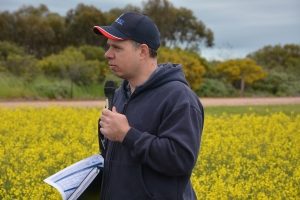
Pre-sowing is an ideal time to analyse data from previous seasons in order to plan and budget for a nutrition strategy for the upcoming season.
It is also a good time to identify and address any variations in soil type, fertility and structure which can cause variability in crop performance.
Agronomy Solutions director Sean Mason, whose work is through a Grains Research and Development Corporation (GRDC) investment, says yield data and normalised difference vegetative index (NDVI) maps can help growers to understand the variability between and within paddocks.
From this data, high and low production zones in paddocks can be mapped out and form the basis of a soil testing strategy.
"It is important to get to the bottom of what is causing the low production zones and how to address it," Dr Mason says.
Soil testing within these zones can determine what is driving the variation, along with residual nutrition prior to sowing to determine a soil management plan.
"Soil testing can ensure that fertiliser strategies based on nutrient replacement rates from the previous crop yields or other approaches are valid and help reduce production costs in some cases," Dr Mason says.
"It is important to take soil samples in the production zones for a site-specific view, rather than a paddock transect.
"It is best to test soil within six to eight weeks of sowing for accurate nitrogen results, but other soil nutrients or characteristics can be sampled any time after harvest.
"Soil nitrogen can change dramatically due to climatic conditions such as rainfall, which can influence nitrogen mineralisation in the soil.
"Pre-sowing soil testing in summer or early autumn usually provides sufficient information on nitrogen levels."
Dr Mason recommends soil testing at least 20 per cent of cropping paddocks, however, some growers may look at more intensive testing.
"I encourage growers to try to be consistent with testing periods and procedures year-to-year for comparable results," he says.
Location of soil sampling is an important factor to consider as some nutrients can be more concentrated in areas such as last year's row.
The majority of the soil samples should be taken within the inter-row, rather than on-row. However, this depends on where the crop will be sown for the year.
Dr Mason says on-row or edge row sowing involves sowing a crop immediately alongside or in the previous crop row.
"This can make use of last year's phosphorous fertiliser, as phosphorous is not a very mobile nutrient in soil," he says.
"However, there could be more potential for nitrogen immobilisation when sowing on-row due to the breakdown of stubble."
Fertcare recommends taking about eight to 10 soil cores between the rows for every core on the rows, if the row spacing is 25 centimetres. If the row spacing is 35 centimetres, this increases to 12 to 15 cores between rows for every core taken on-row.
While most of the nutrients are contained in the top 10 centimetres of soils, deep soil cores can provide valuable information on mobile nutrients and other characteristics in subsoil layers.
Once the deep core sample has been taken, the core should be split into segments, usually 10-20cm, 20-30cm and below 30cm. The 0-10cm segment should be removed from the deep core sample, as shallow core samples are taken in the area surrounding the deep core sampling site.
The samples are then placed in sample bags and sent off for soil testing.
"The grower and agronomist will select which tests are suitable depending on what they are trying to treat or achieve," Dr Mason says.
It is also important to understand the disease burden in the paddock prior to sowing, particularly if sowing a cereal into cereal stubble.
"Diseases such as crown rot can survive for many years in infected plant residues and infection can occur when plants come in close contact with those residues," Dr Mason says.
"PREDICTA® B is a soil testing service which identifies soil-borne diseases that could pose a significant risk to crops.
"This test can be a useful tool to make decisions on which crops or varieties to sow, depending on disease risk."
The PREDICTA® B service is delivered through the South Australian Research and Development Institute's (SARDI) Molecular Diagnostic Centre, a state-of-the art facility capable of delivering high throughput diagnostic testing to industry. Investment in the Molecular Diagnostic Centre and the continued development of PREDICTA® B are components of the GRDC-SARDI strategic research partnership. SARDI is the research division of Primary Industries and Regions SA.






